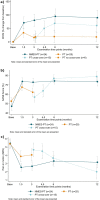Neuromuscular Electrical Stimulation-Enhanced Physical Therapist Intervention for Functional Posterior Shoulder Instability (Type B1): A Multicenter Randomized Controlled Trial
- PMID: 37870503
- PMCID: PMC10824628
- DOI: 10.1093/ptj/pzad145
Neuromuscular Electrical Stimulation-Enhanced Physical Therapist Intervention for Functional Posterior Shoulder Instability (Type B1): A Multicenter Randomized Controlled Trial
Abstract
Objective: Functional posterior shoulder instability (FPSI) (type B1) is a severe type of instability, mainly in teenagers and young adults, that leads to loss of function, pain, and stigmatization among peers. An experimental nonsurgical treatment protocol based on neuromuscular electrical stimulation (NMES) showed very promising early results in the treatment of FPSI. The hypothesis of this study was that NMES-enhanced physical therapy leads to better outcomes than physical therapy alone as the current gold standard of treatment in patients with FPSI.
Methods: In this multicenter randomized controlled trial, patients with FPSI were randomly allocated in a 1:1 ratio to either 6 weeks of physical therapy or 6 weeks of physical therapy with simultaneous motion-triggered NMES. Baseline scores as well as outcome scores at 6 weeks, 3 months, 6 months, and 12 months after the intervention were obtained. The predefined primary outcome of this trial was the Western Ontario Shoulder Instability Index (WOSI) at the 3-month time point.
Results: Forty-nine patients were randomized and eligible for the trial. The group that received physical therapy with simultaneous motion-triggered NMES showed a significantly better main outcome measurement in terms of the 3-month WOSI score (64% [SD = 16%] vs 51% [SD = 24%]). Two-thirds of the patients from the physical therapist group crossed over to the group that received physical therapy with simultaneous motion-triggered NMES due to dissatisfaction after the 3-month follow-up and showed a significant increase in their WOSI score from 49% [SD = 8%] to 67% [SD = 24%]. The frequency of instability episodes showed a significant improvement in the group that received physical therapy with simultaneous motion-triggered NMES at the 3-month follow-up and beyond, while in the physical therapist group, no significant difference was observed.
Conclusion: The current study shows that NMES-enhanced physical therapy led to statistically significant and clinically relevant improvement in outcomes in the treatment of FPSI compared to conventional physical therapy alone-from which even patients with prior unsatisfactory results after conventional physical therapy can benefit.
Impact: Based on the results of this study, NMES-enhanced physical therapy is an effective new treatment option for FPSI, a severe type of shoulder instability. NMES-enhanced physical therapy should be preferred over conventional physical therapy for the treatment of patients with FPSI.
Keywords: Functional Shoulder Instability; Motion-Activated NMES; Neuromuscular Electrical Stimulation; Physiotherapy; Posterior Shoulder Instability.
© The Author(s) 2023. Published by Oxford University Press on behalf of the American Physical Therapy Association.
Figures




References
-
- Glousman R, Jobe F, Tibone J, Moynes D, Antonelli D, Perry J. Dynamic electromyographic analysis of the throwing shoulder with glenohumeral instability. J Bone Joint Surg Am. 1988;70:220–226. - PubMed
-
- Kronberg M, Nemeth G, Brostrom LA. Muscle activity and coordination in the normal shoulder. An electromyographic study. Clin Orthop Relat Res. 1990;257:76–85. - PubMed
Publication types
MeSH terms
Grants and funding
LinkOut - more resources
Full Text Sources
Medical

